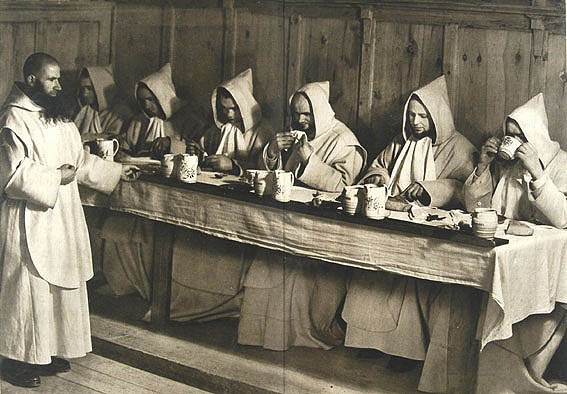It’s a challenge to teach about monasticism and the rules of Sts. Basil and Benedict. Many people say, before they’ve made the effort: How are they relevant and why do I need these antiquated rules or the monastic ideal in an age when there is little interest in the religious life – or religion in general?
But after more than two decades of teaching monasticism, I would argue that Sts. Basil’s and Benedict’s rules never fail to attract students with their simplicity, profundity, and authenticity. And there are practical messages as well, such as the monastic virtue of hospitality.
St. Benedict’s Rule is quite specific: “Let all guests who arrive be received like Christ.” And be open and ready to be surprised by the way guests might reveal the face of Christ to you. The logic goes: monks have been received as guests by the Lord. Therefore, they are called to give the same hospitality to guests and travelers.
“Let the abbot pour water for the guests’ hands and let both the abbot and the community wash the feet of all guests,” following the example of Christ at the Last Supper. The rule strikes a balance, however, between absolute hospitality (which even included bending the rule and in some circumstances permitting “breaking the fast”) and not allowing guests to disrupt the community.
Monasteries in the East and West alike also had a porter or gatekeeper, who were hospitable to guests, but screened them before they entered the monastery in order to safeguard the community:
Let there be stationed at the monastery gate a wise and elderly monk who knows how to receive an answer and to give one and whose ripeness of years does not suffer him to wander about. This porter ought to have his cell close to the gate so that those who come may always find someone there from whom they can get an answer. (Rule of St. Benedict, 66)
In St. Basil’s Asketikon the porter – besides screening – examined and trained potential candidates. So, the practical result was that though the monastic rules prescribed abundant hospitality and mercy to strangers, there was a screening process, which made clear that the rules of the community needed to be respected and the common good preserved.
We can’t read these precepts today without thinking about the current crisis of immigration. Even figures like St. Thomas Aquinas shed light on these questions. In the Summa Theologiae, for example, he asks: Whether the judicial precepts regarding foreigners were framed in a suitable manner? And he answers: “Man’s relations with foreigners are twofold: peaceful, and hostile: and in directing both kinds of relation the Law contained suitable precepts.” (ST Ia IIae, Q 105, a 3)
What St. Thomas is saying is that one rule does not fit all; discernment and a case-by-case approach should be applied in receiving foreigners, because there are wide and significant differences between one set of circumstances and another. According to St. Thomas, nations have the right to control their borders and determine if the newcomers are beneficial and would contribute to the common good. Those qualifications are an integral part of his proposed “peaceful” policy towards newcomers.
All incoming foreigners should be law-abiding, and the state receiving them has the duty to apply – and expect them to follow – the law of the land.
For St. Thomas, national unity and the common good go hand in hand with the principle that no foreigner or traveler be molested or maltreated. Uncontrolled immigration has the potential to destroy the common good.
The argument he makes about integration of foreigners is pertinent and important. Pope Francis, contrary to what many believe, has spoken both of the right of receiving nations to be “prudent” about immigrants and refugees and, as he said in an interview with the Spanish publication El País, “The problem is integration. When there is not integration, ghettos spring up.” For Pope Francis, the ultimate goal of immigration is integration in the new adopted culture and country – not ghettoization. Immigrants too have obligations to become part of the fabric of society and contribute to the general welfare, similar to the nation’s “native” citizens.
At a time when immigration issues are so hotly contested, there are some deeper lessons about hospitality to foreigners to draw from the wisdom of Sts. Basil, Benedict, and Thomas. They accepted the stranger, foreigner, and traveler mercifully, with open hearts faithfully applying the Biblical principles of hospitality. They believed in screening the people who entered the monastery and the nation, however, for the purpose of safeguarding the common good and not endangering their common life. The medievals surrounded their monasteries with high and protective walls, but those imposing walls also had merciful, similarly imposing, open doors.
The wisdom, practicality, and merciful hearts of medievals make millennials, like my students, read and appreciate monastic wisdom. The rest of us could benefit from studying them as well.















